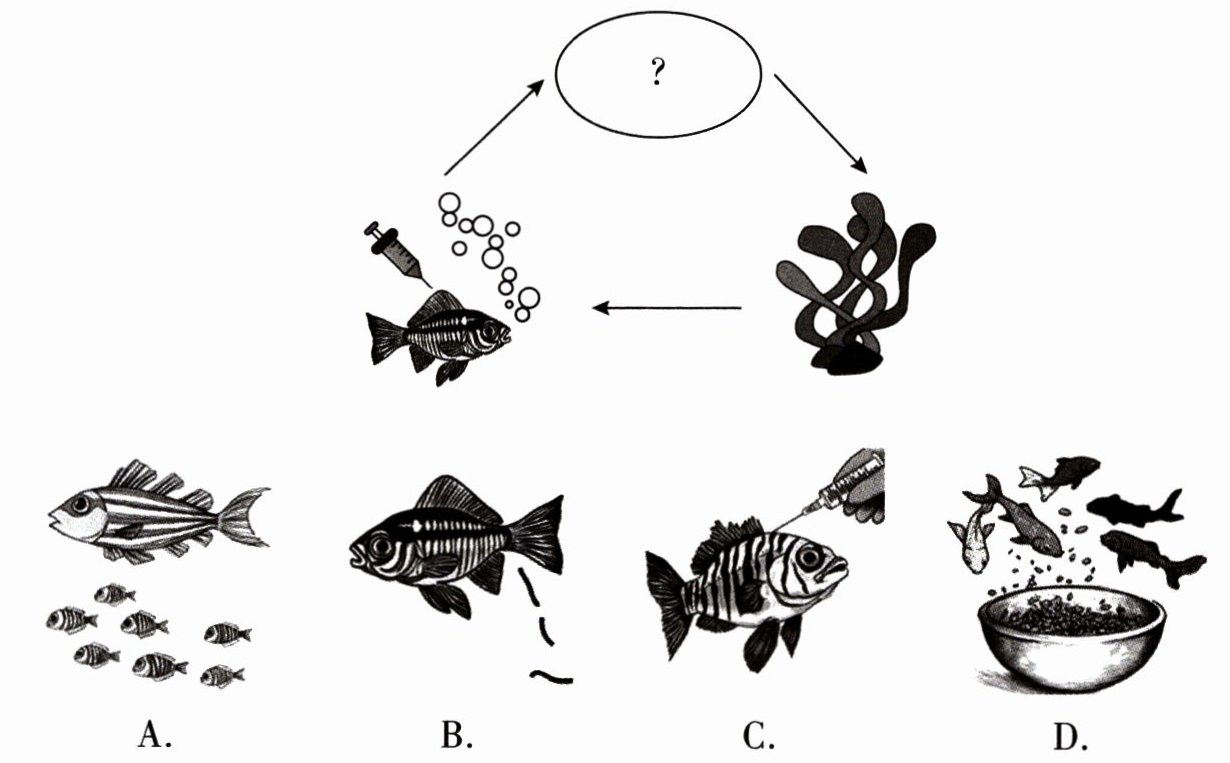B
Fish babies in space? In a space study on zebrafish, Chinese had a new record. They successfully got four zebrafish to live and grow in a closed water world.
The zebrafish went to China's space station on the Shenzhou-18 spaceship on April 25. They then lived in a closed fish tank with some plants. The fish grew up and had babies in 43 days.
In their special closed water world, the plants made air for the fish and the fish's waste gave the plants food. The scientists gave the fish food through a special needle (针管).
Such a closed-loop ecosystem is important for the future study in space. It means that plants and animals can live in space more simply and easily.
The scientists also found that the zebrafish acted differently than on earth. For example, they often swam on their back. The low gravity(重力) in space is a big reason. On earth, gravity pulls everything to earth's centre, and animals can find their way easily. Gravity also makes their bodies work harder and become stronger.
Humans and zebrafish share 70% of the same genes. So the new finding will help scientists better understand human health.
(
A. It took place in a closed water world.
B. The zebrafish gave birth to four babies at last.
C. It took zebrafish less than one month to grow up.
D. Scientists from different countries did it together.
(

(
A. Human bodies got stronger.
B. Animals could easily find their way.
C. The zebrafish swam on their back.
D. The zebrafish swam in different directions.
(
A. The plan of the space study. B. The course of the space study.
C. The meaning of the space study. D. The finding of the space study.
Fish babies in space? In a space study on zebrafish, Chinese had a new record. They successfully got four zebrafish to live and grow in a closed water world.
The zebrafish went to China's space station on the Shenzhou-18 spaceship on April 25. They then lived in a closed fish tank with some plants. The fish grew up and had babies in 43 days.
In their special closed water world, the plants made air for the fish and the fish's waste gave the plants food. The scientists gave the fish food through a special needle (针管).
Such a closed-loop ecosystem is important for the future study in space. It means that plants and animals can live in space more simply and easily.
The scientists also found that the zebrafish acted differently than on earth. For example, they often swam on their back. The low gravity(重力) in space is a big reason. On earth, gravity pulls everything to earth's centre, and animals can find their way easily. Gravity also makes their bodies work harder and become stronger.
Humans and zebrafish share 70% of the same genes. So the new finding will help scientists better understand human health.
(
A
) 4. What do we know about the space study?A. It took place in a closed water world.
B. The zebrafish gave birth to four babies at last.
C. It took zebrafish less than one month to grow up.
D. Scientists from different countries did it together.
(
C
) 5. Which picture should be in the circle to show the ecosystem in the fish tank?
(
C
) 6. What was the result of the low gravity in space?A. Human bodies got stronger.
B. Animals could easily find their way.
C. The zebrafish swam on their back.
D. The zebrafish swam in different directions.
(
C
) 7. What is the last paragraph mainly about?A. The plan of the space study. B. The course of the space study.
C. The meaning of the space study. D. The finding of the space study.
答案:【解析】:
第4题:本题为细节理解题,需要从文章中找到关于太空研究的具体信息。文章第一段明确提到“They successfully got four zebrafish to live and grow in a closed water world.”,说明研究是在一个封闭的水世界中进行的,因此A选项正确。B选项错误,因为文章并未提及斑马鱼最终产下了四条幼鱼;C选项错误,因为文章提到鱼在43天内长大并产下幼鱼,而不是少于一个月;D选项错误,因为文章并未提及这是由多国科学家共同完成的研究。
第5题:本题为图片理解题,需要根据文章描述选择正确的图片来展示鱼缸中的生态系统。文章第三段描述了植物为鱼制造空气,鱼的排泄物为植物提供食物,科学家通过特殊针管给鱼喂食,这是一个闭环生态系统。对比四个选项,只有C选项展示了鱼、植物和科学家通过针管喂食的场景,符合文章描述。A选项只展示了鱼和幼鱼;B选项展示了鱼排出废物,但缺少植物和喂食的场景;D选项展示了多种鱼和食物,但不符合闭环生态系统的描述。
第6题:本题为细节理解题,需要从文章中找到低重力在太空中的影响。文章第五段明确提到“For example, they often swam on their back. The low gravity(重力) in space is a big reason.”,说明低重力导致斑马鱼经常仰泳,因此C选项正确。A选项错误,因为文章并未提及低重力会使人类身体变得更强壮;B选项错误,因为低重力实际上使动物难以找到方向;D选项虽然可能正确,但文章并未明确提及斑马鱼会向不同方向游动。
第7题:本题为主旨大意题,需要理解文章最后一段的主要内容。文章最后一段提到“Humans and zebrafish share 70% of the same genes. So the new finding will help scientists better understand human health.”,说明这一新发现将有助于科学家更好地理解人类健康,这是研究的意义所在。因此C选项“研究的意
义”正确。A选项“研究的计划”、B选项“研究的过程”和D选项“研究的发现”均不符合最后一段的主要内容。
【答案】:
4. A;5. C;6. C;7. C
第4题:本题为细节理解题,需要从文章中找到关于太空研究的具体信息。文章第一段明确提到“They successfully got four zebrafish to live and grow in a closed water world.”,说明研究是在一个封闭的水世界中进行的,因此A选项正确。B选项错误,因为文章并未提及斑马鱼最终产下了四条幼鱼;C选项错误,因为文章提到鱼在43天内长大并产下幼鱼,而不是少于一个月;D选项错误,因为文章并未提及这是由多国科学家共同完成的研究。
第5题:本题为图片理解题,需要根据文章描述选择正确的图片来展示鱼缸中的生态系统。文章第三段描述了植物为鱼制造空气,鱼的排泄物为植物提供食物,科学家通过特殊针管给鱼喂食,这是一个闭环生态系统。对比四个选项,只有C选项展示了鱼、植物和科学家通过针管喂食的场景,符合文章描述。A选项只展示了鱼和幼鱼;B选项展示了鱼排出废物,但缺少植物和喂食的场景;D选项展示了多种鱼和食物,但不符合闭环生态系统的描述。
第6题:本题为细节理解题,需要从文章中找到低重力在太空中的影响。文章第五段明确提到“For example, they often swam on their back. The low gravity(重力) in space is a big reason.”,说明低重力导致斑马鱼经常仰泳,因此C选项正确。A选项错误,因为文章并未提及低重力会使人类身体变得更强壮;B选项错误,因为低重力实际上使动物难以找到方向;D选项虽然可能正确,但文章并未明确提及斑马鱼会向不同方向游动。
第7题:本题为主旨大意题,需要理解文章最后一段的主要内容。文章最后一段提到“Humans and zebrafish share 70% of the same genes. So the new finding will help scientists better understand human health.”,说明这一新发现将有助于科学家更好地理解人类健康,这是研究的意义所在。因此C选项“研究的意
义”正确。A选项“研究的计划”、B选项“研究的过程”和D选项“研究的发现”均不符合最后一段的主要内容。
【答案】:
4. A;5. C;6. C;7. C
解析:
翻译:
### B
太空里的鱼宝宝?在一项关于斑马鱼的太空研究中,中国创造了一项新纪录。他们成功让四条斑马鱼在一个封闭的水世界里生存并成长。
4月25日,这些斑马鱼搭乘神舟十八号飞船进入了中国空间站。之后,它们生活在一个带有一些植物的封闭鱼缸里。这些鱼在43天内长大并产下了鱼宝宝。
在它们这个特殊的封闭水世界里,植物为鱼制造氧气,而鱼的排泄物为植物提供养分。科学家们通过一根特殊的针管给鱼喂食。
这样一个闭环生态系统对未来的太空研究很重要。这意味着植物和动物能更简单、更轻松地在太空中生存。
科学家们还发现,斑马鱼的行为与在地球上时不同。例如,它们经常仰泳。太空中的低重力是一个重要原因。在地球上,重力把所有东西都拉向地球中心,动物们能很容易辨别方向。重力也会让它们的身体更努力地工作,变得更强壮。
人类和斑马鱼有70%的相同基因。所以这项新发现将帮助科学家们更好地了解人类健康。
4. 关于这项太空研究,我们了解到什么?
A. 它在一个封闭的水世界里进行。
B. 这些斑马鱼最后产下了四条鱼宝宝。
C. 斑马鱼用了不到一个月的时间就长大了。
D. 不同国家的科学家一起进行了这项研究。
5. 哪张图片应该放在圆圈里来展示鱼缸里的生态系统?
6. 太空中的低重力带来了什么结果?
A. 人类的身体变得更强壮了。
B. 动物们能很容易辨别方向。
C. 斑马鱼仰泳。
D. 斑马鱼朝不同的方向游动。
7. 最后一段主要讲了什么?
A. 太空研究的计划。
B. 太空研究的过程。
C. 太空研究的意义。
D. 太空研究的发现。
### B
太空里的鱼宝宝?在一项关于斑马鱼的太空研究中,中国创造了一项新纪录。他们成功让四条斑马鱼在一个封闭的水世界里生存并成长。
4月25日,这些斑马鱼搭乘神舟十八号飞船进入了中国空间站。之后,它们生活在一个带有一些植物的封闭鱼缸里。这些鱼在43天内长大并产下了鱼宝宝。
在它们这个特殊的封闭水世界里,植物为鱼制造氧气,而鱼的排泄物为植物提供养分。科学家们通过一根特殊的针管给鱼喂食。
这样一个闭环生态系统对未来的太空研究很重要。这意味着植物和动物能更简单、更轻松地在太空中生存。
科学家们还发现,斑马鱼的行为与在地球上时不同。例如,它们经常仰泳。太空中的低重力是一个重要原因。在地球上,重力把所有东西都拉向地球中心,动物们能很容易辨别方向。重力也会让它们的身体更努力地工作,变得更强壮。
人类和斑马鱼有70%的相同基因。所以这项新发现将帮助科学家们更好地了解人类健康。
4. 关于这项太空研究,我们了解到什么?
A. 它在一个封闭的水世界里进行。
B. 这些斑马鱼最后产下了四条鱼宝宝。
C. 斑马鱼用了不到一个月的时间就长大了。
D. 不同国家的科学家一起进行了这项研究。
5. 哪张图片应该放在圆圈里来展示鱼缸里的生态系统?
6. 太空中的低重力带来了什么结果?
A. 人类的身体变得更强壮了。
B. 动物们能很容易辨别方向。
C. 斑马鱼仰泳。
D. 斑马鱼朝不同的方向游动。
7. 最后一段主要讲了什么?
A. 太空研究的计划。
B. 太空研究的过程。
C. 太空研究的意义。
D. 太空研究的发现。